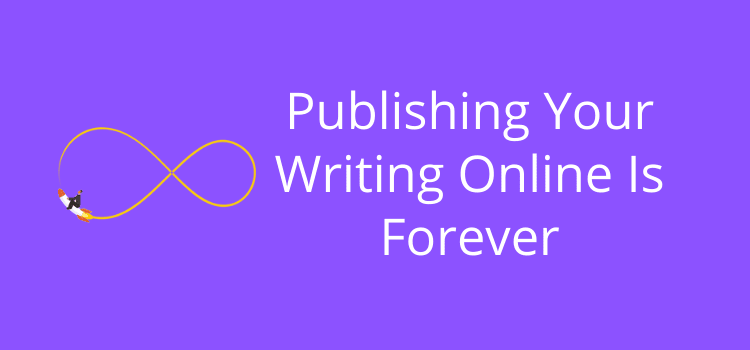
Writers use many tools to correct, format, and improve a text. But one tool stands head and shoulders above them all. It’s the publish button.
You can fuss over every punctuation, vocabulary, and grammar point for hours or even days. But in the end, the only way to know if your writing will resonate with readers is to publish.
Every writer or author hesitates at this final step, with good reason. It’s natural to feel some trepidation.
However, there’s little point in being a writer if no one can read your writing. Publishing is the most vital and logical last step in the writing process.
The publish button is a bridge

You are on one side, and your readers are on the other.
Only when you publish your work can you open the connection between you and your potential readers.
Every time you open the bridge, your chances of success increase.
I read this quote by Loren Baker, founder of the popular site Search Engine Journal.
When people have asked me what’s our secret to ranking content at SEJ, I’ve always told them the publish button because we’ve been building this brand, this entity, and this trust for 20-plus years.
You might not have been writing and publishing for twenty years. But the only way to build your reputation as a writer is to publish.
For a new writer, it can seem like a mountain to climb, and it is.
If you feel like you are at the base of this mountain right now, take heart in knowing that the only way you can go is up.
With each piece of writing you publish, you take one more positive step.
How often should you publish?
Every writer will have a different rhythm or frequency of publishing.
For an author, it might be only once or twice a year. But for a content writer, perhaps once a week or every day.
If you are writing for a news site or publishing on social media, it could be multiple times per day.
For authors, it can also depend on how you publish your books.
With self-publishing, it’s easier and faster to publish when you are sure a book is ready.
But if you sign with a publisher, it could take up to a year or more before your book is published. In this case, you need to have more books in the pipeline.
However, no matter what you write, your publishing frequency shouldn’t come at the expense of quality.
You might have set yourself deadlines.
But if your writing or content isn’t up to the highest standard, you could shoot yourself in the foot.
Yes, you want to develop your publishing rhythm and frequency, but if it comes at the expense of quality, modify your schedule.
I know from first-hand experience how rushing into publishing can be detrimental.
Luckily, however, that was long ago, and I learned quickly from my mistakes.
Since then, I still publish regularly, but it’s on a schedule I can manage and ensure that my writing is always (hopefully) up to standard.
It’s up to you to make the same decisions about your writing. Yes, publish as often as you can, but only do so when it’s ready.
Overcoming your fears
It’s perfectly normal to be a little apprehensive, hesitant, or anxious when you get to the point when you are ready to publish your work.
Writing is never a guaranteed success, and much of what we write may fail to grab readers’ attention.
Worse still is the fear of an unfavorable response or critical comments.
But rejection and criticism are all part of life as a writer.
All you can do is accept that you will have failures and, with a bit of luck, some successes.
When your finger hovers and hesitates over the publish button, take a deep breath and think positively.
As long as you’ve done your best to produce a great piece of writing, forget your fears because it’s time to publish.
Your safety valve – The update button
Publishing today comes with a terrific safety net for writers.
You can always correct, improve, and update, no matter what or how you publish.
It applies to blog posts, online content, ebooks, and even print-on-demand books.
This facility can help take away a lot of the trepidation about publishing your work. It might be an hour later or a year later that you notice a typo. But it’s an easy fix with an update.
When you write content or blog posts, things and times can change.
Perhaps you wrote a great article about how to use Twitter effectively a couple of years ago. The content might still be valuable, but the name has changed to X.
All you need to do is a quick edit and update to make your old content relevant again.
Even if you are an author with a publisher, it’s often possible to request an update to an ebook version.
If your publisher uses print-on-demand and not offset printing, you might also be able to ask for a quick update.
Yes, the publish button is powerful, but always remember that it’s definitely not finality.
Summary
Looking at a blank page and trying to craft a first sentence is often one of the most challenging steps in writing.
At the other end, though, knowing when you are ready to publish is always a decision you take after a lot of checking and consideration.
But they are the two inescapable and essential steps in the writing and publishing process.
If you are hesitant, don’t be. As a writer, you will meet these two elements over and over again.
However, remember that you are working with a safety net, so nothing is forever. You can always change a first sentence, correct a factual error, or expand on a point you forgot to include.
Yes, hitting publish is powerful and can be rewarding or daunting. But it’s not the end, it’s the beginning.
Related Reading: How Long Does It Take To Write And Publish An Article?



